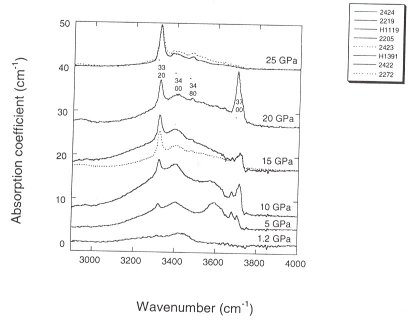

Magnesiowüstite, (Mg,Fe)O, is the second most abundant phase in the lower mantle of the Earth, accounting for about 15 % by volume. The results of a previous study of an Fe-free system shows that water partitions more strongly into periclase (MgO) than into MgSiO3 perovskite (Bolfan-Casanova et al., 2000, EPSL 182: 209-221). Therefore, (Mg,Fe)O could play an important role in storing water in the deep mantle of the Earth. Such water could have important effects on the physical and chemical properties of the lower mantle, including melting temperature, rheology and electrical conductivity.
Single crystals of Mg0.93Fe0.07O were contained in a powdered oxide mixture of the same composition but containing water, added as Mg(OH)2 and H2O. Hydrothermal annealing experiments were performed at 1200°C and pressures ranging between 1.2 and 25 GPa using a multi-anvil apparatus. The sample container consisted of an inner rhenium capsule to avoid iron loss from the sample, and an outer platinum capsule that was sealed by welding. Rhenium oxide was added to the sample and, by reaction with the Re metal, maintained a high oxygen fugacity, between the Ni-NiO and hematite-magnetite buffers. The compositions of the recovered samples were analysed by electron microprobe and the results show very homogeneous Fe contents, which, for the different samples, are almost identical. The infrared spectra of the magnesiowüstite single crystals were recorded using a Fourier transform infrared spectrometer.
The FTIR spectra exhibit multiple OH stretching bands with intensities that show different dependencies on the pressure of hydrothermal annealing (see Fig. 3.4-1). The main bands are located at ~3700, 3480, 3400 and 3320 cm-1. It is possible to unambiguously attribute the
 |
bands at 3320 and 3480 cm-1 to H structurally bound in magnesiowüstite, based on their uniform intensities throughout the samples, as well as their steady increase in intensity with pressure. On the other hand, the intensity of the 3400 cm-1 band seems to decrease with pressure. The nature of the bands at ~3700 cm-1 remains unclear because their intensities are strongly correlated with the presence of inclusions.
Because magnesiowüstite exists predominantly in the Earth's lower mantle, only the bands that are present in the spectra of the very high-pressure samples, namely those at 3480 and 3320 cm-1, are relevant for estimating H solubility in magnesiowüstite in the Earth. The amount of water incorporated in magnesiowüstite at 25 GPa and 1200°C under water saturated conditions is ~100 H/106Mg (~20 ppm wt H2O), based on the bands at 3480 and 3320 cm-1. When integrated over the mass of the entire lower mantle, this amounts to ~7.3 x1018 kg H2O, i.e 0.5 % of the total mass of the oceans.

Tel: +49-(0) 921 55 3700 / 3766, Fax: +49-(0) 921 55 3769, E-mail: bayerisches.geoinstitut(at)uni-bayreuth.de
 Previous page
Previous page